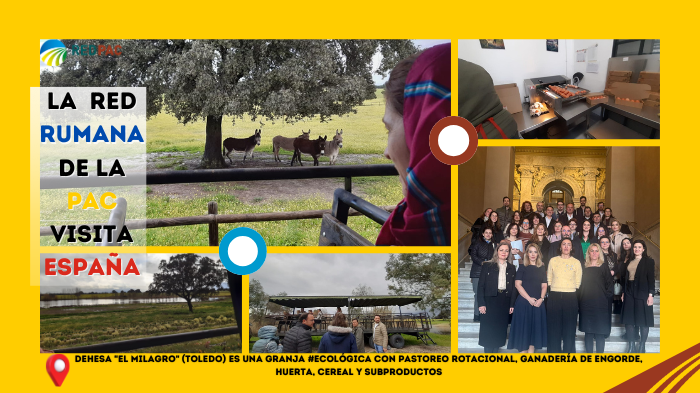
04 de April de 2025
Calidad y cadena alimentaria
Resiliencia y competitividad
Biodiversidad y paisaje
The Romanian National CAP Network, together with other units of its Ministry of Agriculture and Rural Development, have visited our country to exchange knowledge and experiences on the activities of its network and the CAP Network and to learn more about how the CAP Strategic Plan has been implemented in Spain.
- The Romanian National CAP Network together with other units of its Ministry of Agriculture and Rural Development They have visited our country in order to exchange knowledge and experiences on the activities of their network and the CAP Network and to learn in greater depth how the CAP strategic plan has been implemented in Spain.
- During their stay, they had the opportunity to visit various good practices related to agricultural sustainability and rural development in Castilla La Mancha and Andalusia.
Romania has almost a quarter of the agricultural land of Central and Eastern European countries and 10.65% of the agricultural land in the European Union (EU). Thus, according to data from the Romanian Ministry of Foreign Affairs, agriculture contributes 4.5% to Romania's GDP and employs 23% of the working population, a figure significantly higher than the EU average of 4-5%.
Romania's Common Agricultural Policy Strategic Plan (CASP) 2023-2027 is aligned with the overall objectives of the reformed CAP , which seeks fairer, greener, and results-oriented agriculture. However, it presents some specific data, such as that Romania's CASP allocates around €1.1 billion to investments in farms and processing units, with the aim of improving agricultural competitiveness. Furthermore, 611,000 hectares of land in Romania are expected to adopt organic practices in high nature value areas to protect biodiversity, according to Romania's CAP Strategic Plan 2023-2027 (data provided by elrumano.com ).
With these objectives in mind, the Romanian National CAP Network visited Spain from March 10th to 14th, seeking to identify good agricultural and rural sustainability practices that could serve as a reference for their country's CAP. To this end, they initially met with experts from the Ministry of Agriculture, Fisheries and Food ( MAPA ) to learn firsthand about the technical aspects of the Spanish CAP (its evaluation, eco-regimes, LEADER, and the organization and work of the CAP Network). During the rest of the week, the CAP Network acted as host, guiding them through various agricultural holdings and LEADER projects in the region, alongside the Local Action Groups and management authorities of each of the territories visited.
Guided tours and good practices
Theterritories visited by the Romanian expedition, supported by the Spanish PAC Network, were Toledo and Seville, on visits made on different days. The trip began on Tuesday, March 11, with a visit to Dehesa El Milagro. (Toledo), a farm with nearly 300 certified organic hectares located in the Oropesa region. The livestock area is dedicated to Avilanian breed cows crossed with Limousin and purebred Avilanian oxen, Talavera breed sheep, broiler chickens and slow-growing hairless capons, and laying hens. As for agriculture, they have 80 hectares of crops, dedicated to orchards and greenhouses, stone fruit trees, meadows, and reforestation of native trees.
The next day, the visits started in Andalusia, specifically at PÂTISSERIE TOKYO (Gerena, Seville), a micro-bakery with signature pastries and ice creams, made with innovative techniques: using pure, high-quality, organic natural ingredients from local suppliers following fair trade criteria. The project was launched thanks to the LEADER approach. That same day, the visits continued to the Wine Museum at Bodegas Salado (Umbrete, Seville), a wine tourism project with over two centuries of history and countless awards and recognitions, the flagship project of the Aljarafe-Doñana Local Action Group .
On Thursday the 13th, the visits continued at the MORÓN LIME MUSEUM (Morón de la Frontera, Seville), dedicated to the recovery and preservation of the world of lime, which was declared an intangible symbol of humanity by UNESCO in 2011. Its facilities include rehabilitated kilns, various infrastructures, and buildings to showcase some of the activities traditionally carried out with lime. Following this, the Romanian colleagues were able to meet the H2Olivetree Operational Group (La Puebla de Cazalla, Seville), created to reuse wastewater to irrigate olive groves through the management of olive grove effluents, i.e., water from the olive dressing industry. During this visit, they learned about an innovative project firsthand.









